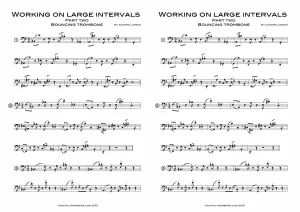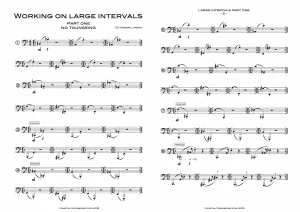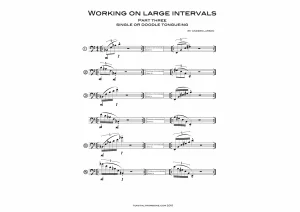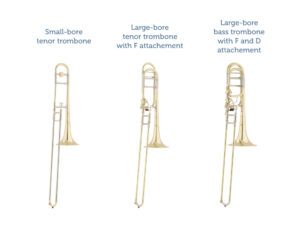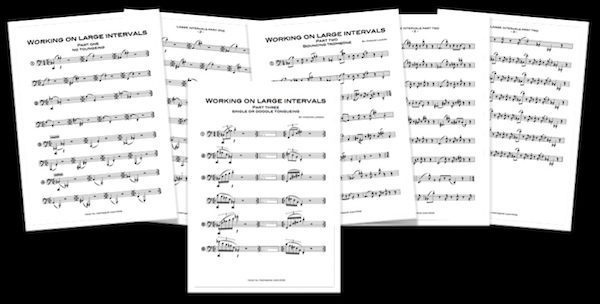
Bouncing ‘bone and large leaps
Being able to switch registers rapidly and with ease, is a key to a relaxed trombone technique. In this trombone lesson, I give you some advice on how to achieve this, combined with five pages of exercises. Before you download and print the free trombone sheet music, please read the full article. That will help you get the most out of the exercises.
Just a few millimeters…
The distance between high notes and low notes is only a few millimeters. Moving the cheek a few millimeters down, and increasing the distance between the lips another few millimeters is basically all it takes to make a leap of an octave. The problem is, that many of us brass players (myself included if I don´t focus while playing) tend to engage too many muscles and strange parts of our body when we play large intervals.
Playing a low note with a big sound is only possible with a large opening between your lips, and by moving your cheek slightly down and out. Air compression will be low. Besides making sure that the embouchure is stable, playing low notes should be a very relaxed task, and your focus should be on moving a lot of air.
Playing higher notes requires a smaller lip opening and a higher cheek position. This will automatically lead to higher air compression.
❗Air compression is a result, not a tool❗
This is a really important notice: Correct high note embouchure combined with an open throat will trigger higher air compression. Increasing compression will NOT trigger correct high note embouchure or airflow.
What this means, is that you should focus on the embouchure and airflow, and let the autonomous parts of your breathing machinery establish the required level of compression. Brass educators have come up with many useful tricks to achieve this:
- Focus on the air passing through your lips
- Move focus from your body to the trombone bell
- Imagine hitting a spot on the wall with the notes you play
If you try to use compression to go from a low register to a higher one, you are likely to fail. You might hit the note you aim for, but use way more force than necessary. Changing the embouchure is a rapid movement and can be done with ease.
Try reading this very sentence out loud to yourself, and notice how you move your lips and tongue with extreme precision and speed.
All of this is done without having to focus on moving air across your vocal cords. This is more or less autonomous. You want to use this skill set when playing a brass instrument! Moving around between high and low range on your trombone embouchure is basically a form of speaking. And since music is a universal language, this should be a good match.
Large intervals exercises – part one
These are basic exercises to enable you to play large intervals in a relaxed manner. Please note the dynamics indicated in exercises 1, 3, 5, and 8. When you play a mf low note and jump to a high note played in p, your air compression will remain the same. This way, you can focus on rapid embouchure changes, while not having to change your breathing.
When playing intervals going down (exercise 2, 4, 6, and 7), I suggest that you play both notes in a mf.
If some of the exercises are too advanced or get too tricky when you get beyond a particular slide position, just skip them. The goal is to make your playing more relaxed and nimble, not pushing yourself over the edge.
Large intervals exercises – part two
These flexibility exercises combine short notes, rhythm, and slurred notes. Play the short notes as bouncy as possible. Also, make sure to keep a rhythmical flow with a focus on the horizontal movement rather than the individual notes. I recommend plying it both with and without tongue in the large slurred intervals.
Large intervals exercises – part three
This section is primarily for the advanced trombone player. The goal here is to get the speed up while keeping a light and easy feel. If you are familiar with doodle tonguing, I recommend that you use that here. If not, go for a fast single tongue. Or work on both!
The hardcore way of playing section three is to use natural legato. Try to make kind of a glissando between the notes. You should hear the partials as you pass them, like tumbling down (or up!) the stairs on your behind, feeling each step along the way. Should be less painful on the trombone though.
You can download and print this exercise from the member’s section. Start your free trial now, and get access to more than 2.000 pages of trombone sheet music – all with clear instructions.
The end result
Here is what happens if you practice large intervals for more than 10.000 years straight, professionally demonstrated by jazz trombone monster, Marshall Gilkes.
Good luck!
Anders Larson
10 Comments
-
THANK YOU. At 85yrs old ITS GOOD TO HAVE exercises like this, jasper
-
Thank you, Great, jasper
-
Thanks for trying to help those of us with less talent. Progress comes very slowly for the untalented so it is important for us to be inspired by generous experts like you.
Best Regards,
John -
Pages 4-6 come out as jibberish?
Lee
-
Try reloading the page / print it again, looks fine at my end!
Anders -
Good exercises for all brass. Will add them to my routines as a euphonium player.
-
Dank je wel voor de geweldige oefeningen.
-
Very useful and interesting exercises. Thank you so much for sharing and inspiring all of us!
John
-
Thank you for sharing this exercise. I’m trying to increase my range in both directions. This will probably help me significantly.
-
I ´m comming back to study trombone and you are helpping me to reach my target. That´s very kind of you. Thanks so much for to share all your knowledge.


